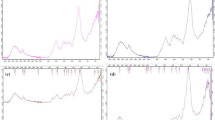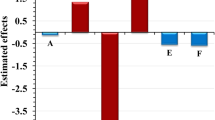Abstract
This study reveals the efficient bio-sorption of Cr(VI) species from simulated wastewater using raw (RSV), acid-activated (PSV) and chelated-activated (PSV-C) Sterculia villosa Roxb. shells. Batch optimization experiments were carried out for determining the optimal pH, dosage of bio-sorbent, initial Cr(VI) concentration and incubation temperature. Physico-chemical alterations in the bio-sorbents prior and following bio-sorption of Cr(VI) species were characterized. Equilibrated experimental data at different temperatures was evaluated as a function of time for understanding the isotherm, kinetics and thermodynamics of the bio-sorption process. Sorption rates for all the bio-sorbents (RSV, PSV and PSV-C) alternately fitted to the Langmuir isotherm model and Langmuir maximum adsorption capacity for RSV, PSV and PSV-C were found to be 57.78, 163.51 and 188.68 mg/g, respectively. Cr(VI) sorption by these bio-sorbents followed pseudo-second–order kinetics. Thermodynamic studies suggest endothermic interaction and increased degree of randomness between the bio-sorbents and Cr(VI) species. Regeneration of the bio-sorbents following sorption–desorption revealed that it can be reused and recycled for several times for Cr(VI) removal from wastewater.

Graphical abstract






Similar content being viewed by others
References
Ahmed MJK, Ahmaruzzaman M (2016) A review on potential usage of industrial waste materials for binding heavy metal ions from aqueous solutions. J Water Process Eng 10:39–47
Aljeboree AM, Alshirifi AN, Alkaim AF (2017) Kinetics and equilibrium study for the adsorption of textile dyes on coconut shell activated carbon. Arab J Chem 10:S3381–S3393
Babel S, Kurniawan TA (2003) Low-cost adsorbents for heavy metals uptake from contaminated water: a review. J Hazard Mater 97:219–243
Barakat MA (2011) New trends in removing heavy metals from industrial wastewater. Arab J Chem 4:361–377
Bendjeffal H, Djebli A, Mamine H, Metidji T, Dahak M, Rebbani N, Bouhedja Y (2018) Effect of the chelating agents on bio-sorption of hexavalent chromium using Agave sisalana fibers. Chin J Chem Eng 26:984–992
Bhaumik M, Agarwal S, Gupta VK, Maity A (2016) Enhanced removal of Cr(VI) from aqueous solutions using polypyrrole wrapped oxidized MWCNTs nanocomposites adsorbent. J Colloid Interface Sci 470:257–267
Burakov AE, Galunin EV, Burakova IV, Kucherova AE, Agarwal S, Tkachev AG, Gupta VK (2018) Adsorption of heavy metals on conventional and nanostructured materials for wastewater treatment purposes: a review. Ecotoxicol Environ Saf 148:702–712
Chang L, Ehrlich RS (1999) The relationship between adsorption of Cr(VI) and soil properties AU - Lee, Suen-Zone. J Environ Sci Health A 34:809–833
Cherdchoo W, Nithettham S, Charoenpanich J (2019) Removal of Cr(VI) from synthetic wastewater by adsorption onto coffee ground and mixed waste tea. Chemosphere 221:758–767
Chojnacka K (2010) Biosorption and bioaccumulation – the prospects for practical applications. Environ Int 36:299–307
Costa M (2003) Potential hazards of hexavalent chromate in our drinking water. Toxicol Appl Pharmacol 188:1–5
Danish M, Ahmad T (2018) A review on utilization of wood biomass as a sustainable precursor for activated carbon production and application. Renew Sust Energ Rev 87:1–21
Demirbas A (2008) Heavy metal adsorption onto agro-based waste materials: a review. J Hazard Mater 157:220–229
Deng S, Bai R (2004) Removal of trivalent and hexavalent chromium with aminated polyacrylonitrile fibers: performance and mechanisms. Water Res 38:2424–2432
Deshpande L, Juneja HD (2012) Chemical speciation of chromium in water: a review AU – Rakhunde, Rupali. Crit Rev Environ Sci Technol 42:776–810
Dubinin MM (1965) Modern state of the theory of volume filling of micropore adsorbents during adsorption of gases and steams on carbon adsorbents. Zh Fiz Khim 39:1305–1317
Enniya I, Rghioui L, Jourani A (2018) Adsorption of hexavalent chromium in aqueous solution on activated carbon prepared from apple peels. Sustain Chem Pharm 7:9–16
Freundlich H, Heller W (1939) The adsorption of cis- and trans-azobenzene. J Am Chem Soc 61:2228–2230
Frumkin A, Physic Z (1925) Chem Bd 116:466
Fu F, Wang Q (2011) Removal of heavy metal ions from wastewaters: a review. J Environ Manag 92:407–418
Gupta VK, Agarwal S, Saleh TA (2011) Chromium removal by combining the magnetic properties of iron oxide with adsorption properties of carbon nanotubes. Water Res 45:2207–2212
Han R, Zhang J, Han P, Wang Y, Zhao Z, Tang M (2009) Study of equilibrium, kinetic and thermodynamic parameters about methylene blue adsorption onto natural zeolite. Chem Eng J 145:496–504
Ho YS, Mckay G (1999) Pseudo-second order model for sorption processes. Process Biochem 34:451–465
Khezami L, Capart R (2005) Removal of chromium(VI) from aqueous solution by activated carbons: kinetic and equilibrium studies. J Hazard Mater 123:223–231
Lagergren S (1898) Handlingar Band. 24:1–39
Langmuir I (1918) The adsorption of gases on plane surfaces of glass, mica and platinum. J Am Chem Soc 40:1361–1403
Ma H, Yang J, Gao X, Liu Z, Liu X, Xu Z (2019) Removal of chromium (VI) from water by porous carbon derived from corn straw: influencing factors, regeneration and mechanism. J Hazard Mater 369:550–560
Milonjic S (2007) A consideration of the correct calculation of thermodynamic parameters of adsorption
Naghipour D, Gharibi H, Taghavi K, Jaafari J (2016) Influence of EDTA and NTA on heavy metal extraction from sandy-loam contaminated soils. J Environ Chem Eng 4:3512–3518
Nakkeeran E, Patra C, Shahnaz T, Rangabhashiyam S, Selvaraju N (2018) Continuous biosorption assessment for the removal of hexavalent chromium from aqueous solutions using Strychnos nux vomica fruit shell. Bioresour Technol Rep 3:256–260
Prasad MNV, Nakbanpote W, Phadermrod C, Rose D, Suthari, S (2016) Mulberry and Vetiver for Phytostabilization of Mine Overburden: Cogeneration of Economic Products. Bioremediation and Bioeconomy, Chap 13:295-328
Ramachandra Rao S (2006) Chapter 4 - hydrometallurgical processes. In: Rao SR (ed) Waste Management Series. Elsevier
Rangabhashiyam S, Selvaraju N (2015a) Efficacy of unmodified and chemically modified Swietenia mahagoni shells for the removal of hexavalent chromium from simulated wastewater. J Mol Liq 209:487–497
Rangabhashiyam S, Selvaraju N (2015b) Evaluation of the biosorption potential of a novel Caryota urens inflorescence waste biomass for the removal of hexavalent chromium from aqueous solutions. J Taiwan Inst Chem Eng 47:59–70
Redlich O, Peterson DL (1959) A useful adsorption isotherm. J Phys Chem 63:1024–1024
Rodrigues DAS, Moura JM, Dotto GL, Cadaval TRS, Pinto LAA (2018) Preparation, characterization and dye adsorption/reuse of chitosan-vanadate films. J Polym Environ 26:2917–2924
Rosales E, Meijide J, Tavares T, Pazos M, Sanromán MA (2016) Grapefruit peelings as a promising biosorbent for the removal of leather dyes and hexavalent chromium. Process Saf Environ Prot 101:61–71
Saranya N, Ajmani A, Sivasubramanian V, Selvaraju N (2018) Hexavalent chromium removal from simulated and real effluents using Artocarpus heterophyllus peel biosorbent - batch and continuous studies. J Mol Liq 265:779–790
Schmidt S-A, Gukelberger E, Hermann M, Fiedler F, Grossman B, Hoinkis J, Ghosh A, Chatterjee D, Bundschuh J (2016) Pilot study on arsenic removal from groundwater using a small-scale reverse osmosis system—towards sustainable drinking water production. J Hazard Mater 318:671–678
Sharma A, Thakur KK, Mehta P, Pathania D (2018) Efficient adsorption of chlorpheniramine and hexavalent chromium (Cr(VI)) from water system using agronomic waste material. Sustain Chem Pharm 9:1–11
Sinha V, Pakshirajan K, Chaturvedi R (2015) Evaluation of Cr(VI) exposed and unexposed plant parts of Tradescantia pallida (Rose) D. R. Hunt. for Cr removal from wastewater by biosorption. Int J Phytoremediation 17:1204–1211
Vijayaraghavan K, Padmesh TVN, Palanivelu K, Velan M (2006) Biosorption of nickel(II) ions onto Sargassum wightii: application of two-parameter and three-parameter isotherm models. J Hazard Mater 133:304–308
Weber WJ, Morris JCS (1962) Advances in water pollution research. Proceedings of the First International Conference on Water Pollution Research 2:231
Acknowledgements
The authors are grateful to the Department of Biosciences and Bioengineering, Indian Institute of Technology Guwahati, for providing the necessary facilities for this research work. The authors also acknowledge the Central Instrumentation Facility (CIF), Indian Institute of Technology Guwahati, for characterization of the bio-sorbents.
Funding
The authors thank the IITG Start-up Research Grant (Grant No. BSBESUGIITG01213xSEN001) for funding the research.
Author information
Authors and Affiliations
Corresponding author
Additional information
Responsible editor: Tito Roberto Cadaval Jr
Publisher’s note
Springer Nature remains neutral with regard to jurisdictional claims in published maps and institutional affiliations.
Rights and permissions
About this article
Cite this article
Patra, C., Medisetti, R.M.N., Pakshirajan, K. et al. Assessment of raw, acid-modified and chelated biomass for sequestration of hexavalent chromium from aqueous solution using Sterculia villosa Roxb. shells. Environ Sci Pollut Res 26, 23625–23637 (2019). https://doi.org/10.1007/s11356-019-05582-4
Received:
Accepted:
Published:
Issue Date:
DOI: https://doi.org/10.1007/s11356-019-05582-4




